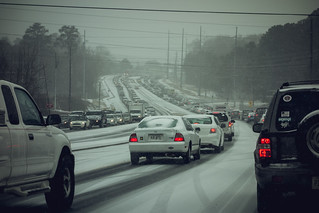A couple of quick thoughts on Atlanta’s Snowpocalypse
The following was originally a comment on Facebook, but I did my thing and went on way too long, so I’m posting it here, as well.
Ok, here’s what I see (and I’m not actually THERE at the moment, so I’m having to go by reports, so if I’ve gotten anything terribly wrong, let me know). They knew the storm was coming, but it was forecast to hit well south of the city. Atlanta was supposed to get a dusting of snow at worst–something that gums things up a bit, but isn’t a catastrophe. Nonetheless, the city proper had its salt trucks and plows ready (a combined fleet of about 70, I’m told), but because of the massive traffic jam, they couldn’t be effectively deployed to clear the roads.
And the massive traffic jam is actually where this story should really start. In the face of a winter storm that wasn’t even forecast to have too much of an effect on the city and its north suburbs, schools, governments, and most businesses took a calculated risk to operate as usual. But then, the snow started falling fast and heavy WAY further north than expected, and everyone had the same idea/reaction at once: “Oh shit, lets send everyone home before the roads get too bad.” Which, ironically, made the roads worse than any ice, rain, or snow possibly could.
How could this have been prevented? It’s difficult to say with certainty exactly when everyone realized that Atlanta was going to get much more ice and snow than originally predicted, but I’ve seen school cancelled and places close for even the *threat* of snow that never actually came. I know that when that happens there’s always a little embarrassment and there is a cost to that, as well, but this is certainly one of those cases where shutting things down in advance of the storm hitting would have been the wise thing to do. But hindsight being what it is, let’s just say, ok, it wasn’t done, so how could what happened have been managed better?
For one, some kind of plan in place for a staggered send-home schedule for inclement weather would be a wise move to prevent the gridlock that occurred. This does put some people on the road once conditions have become more hazardous, but it would keep traffic moving and prevent 30-minute commutes turning into 13-hour odysseys that end not at home but at a pop-up warming shelter in a Home Depot. (I do have to say, good on some businesses making the best of having stranded employees and opening their doors to keep everyone warm.) I’m not certain how this staggered schedule should function or what the best way to set it up to make it both efficient and fair, but we’ve got time before the next snowpocalypse to hammer something out.


